Adorned in pastel hues with soft brush strokes, the painting by Im Pesey glowed with a warm, impressionistic feel at the Dongdaemun Design Plaza in Seoul last week.
The work of the Cambodian artist, titled “Liveliness,” depicted bustling activities at the Central Market in capital Phnom Penh in the early 1990s, a fledgling period after the harrowing internecine war.
“I wanted to draw the situation in Phnom Penh right after the war, with people restarting their lives and various commercial activities springing up across the city,” the artist told The Korea Herald. “People must have felt calm and peaceful back then, after decades of bloody war with the Khmer Rouge regime. I sketched using my imagination and also took inspirations from old photos.”
Im was one of 30 artists from the Association of Southeast Asian Nations, whose 60 artworks are on display at an exhibition in Seoul. Organized by the ASEAN-Korea Center in Seoul in conjunction with the 2017 Asian Students and Young Artists Art Festival, the event runs through Aug. 20 featuring everything from oil paintings to installation pieces. Ten artists from ASEAN were invited to showcase their works, network and discuss their vocational issues with their Korean counterparts and art directors.
 |
Cambodian artist Im Pesey stands in front of his paintings on his right at the 2017 Asian Students and Young Artists Art Festival at Dongdaemun Design Plaza in Seoul on July 25. (Joel Lee/The Korea Herald) |
The years under the Khmer Rouge from 1968 to 1994 have remained “a very sad story” of his homeland, said Im. The communist armed guerilla group led by politician and revolutionary Pol Pot and others carried out numerous genocides of Cambodian minorities, killing an estimated 1.5 to 3 million people in the late 1970s.
“Everything was destroyed and Cambodians had nothing to live off,” he said, adding several members of his own family and relatives died or became casualties.
“Although I was not born at that time, I heard about the appalling tales from my family, relatives and teachers. The young Cambodians have been taught to study the history so that the ghosts of our dark past will never haunt us again.”
Young Cambodians today understand that peace is priceless and nonnegotiable, both within their national borders as well as across borders, he added.
Im, who also teaches at private Japanese institution Yamada School of Art in Phnom Penn, said the new voices of Cambodia desire fervently to be “part of the new story” of nation-building unfolding in the country.
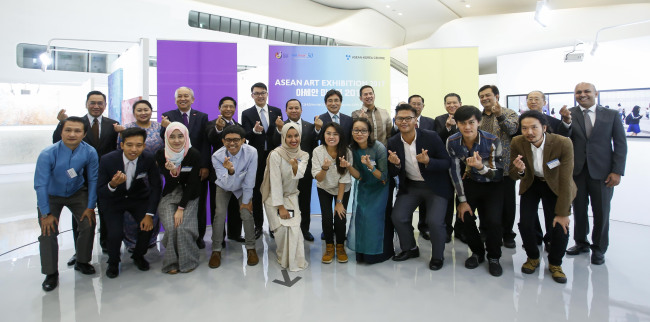 |
ASEAN ambassadors (back row) and artists (front row) pose together at the 2017 Asian Students and Young Artists Art Festival at Dongdaemun Design Plaza in Seoul on July 25. The exhibition runs through Aug. 20 featuring 60 works by ASEAN artists. (ASEAN-Korea Center) |
“We need to build our economy, society, education and culture, and art is very important in this respect,” he said. Im stressed that artists have a duty to regain the glory of ancient Cambodian art that created the likes of the 12th-century Hindu-Buddhist temple-complex of Angkor Wat.
The art of the Khmer Empire (802–1431), centered on its capital Angkor, created magnificent edifices and stone carvings that survive to this day. Traditional Cambodian arts and crafts include textiles, non-textile weaving, silversmithing, stone carving, lacquerware, ceramics, wat murals and kite-making, largely produced for practical use or royal functions.
Following decades of artistic decline in the late 20th century under the Khmer Rouge, art has experienced a revival on the back of increased support from the government, nongovernmental organizations and foreign tourists.
The average Cambodian does not know much about art, and does not have much money to spend on it, Im said, but the growing number of foreign tourists and businesspeople have become Cambodian artists’ main patrons.
“Still, artists have to work hard to promote their works, advertising online and social media and building connections,” according to Im. “It requires a strong conviction to be an artist.”
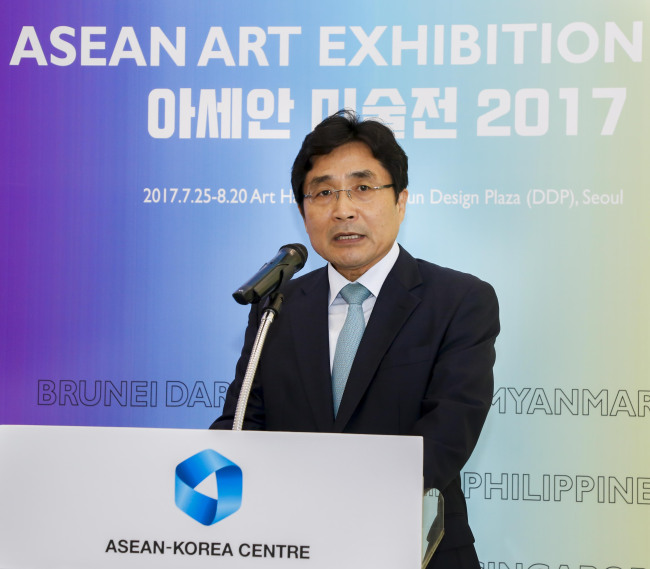 |
The ASEAN-Korea Center Secretary General Kim Young-sun -- former Korean Ambassador to Indonesia from 2011-14 -- speaks at the 2017 Asian Students and Young Artists Art Festival at Dongdaemun Design Plaza in Seoul on July 25. The exhibition runs through Aug. 20 featuring 60 works by ASEAN artists. (ASEAN-Korea Center) |
Im said he likes to draw humble, rustic lives of people and unsullied landscapes in the impressionistic style. He argued that art is a crucial tool for promoting Cambodian culture and society, as the country remains culturally obscure on the world stage.
“Artists have the power to bridge Cambodia with other countries around the world,” he said. “I want my paintings to give joy and merriment to people otherwise feeling melancholic and stressed from their lives. I want to illuminate our beautiful people and nature.”
Oni Jamsari, a Malaysian artist from Kuala Lumpur, featured two artworks outlining women’s silhouettes at the event.
A native of the industrious Malaysian capital, Jamsari said she longed for the years when Kuala Lumpur was still relatively undeveloped and blessed with natural rivers, woods and farmland. One of her works mimics the city’s unadulterated landscape with verdant greens and shadows, harking back to an age without electricity. She also used the same nails worked with by her father in building their home.
Describing Malaysia as a vibrant multicultural nation, Jamsari said artists of various ethnicities, including Malay, Chinese, Indian, indigenous peoples and others, bounce ideas off each other for inspiration and collaborate without prejudice.
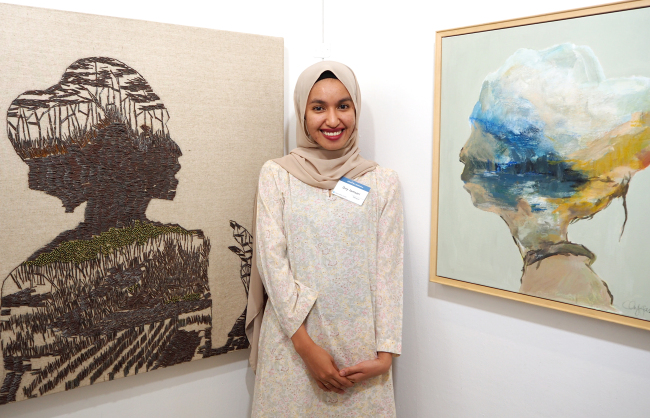 |
Oni Jamsari, a Malaysian artist from Kuala Lumpur (Joel Lee/The Korea Herald) |
“Ethnic Chinese artists draw traditional Malay clothing or use it as a material, while Muslim artists decorate their works of art with Chinese and Indian symbols,” she explained. “Because we grew up together, it’s very easy and natural to identify ourselves with different national designs.”
Jamsari conceded that it was not easy to earn money as an artist in Malaysia, but “there are still ways to be commercially viable” by harnessing connections and promoting their talents on traditional and social media.
“Artists need to push themselves to be smart and stay in touch with potential buyers and dealers,” she said. “You need to continue to expose yourself through exhibitions, media interviews, etc., but don’t push too much. Just do it smoothly. It’s like any other job.”
Noting that Korean movies, television dramas and K-pop music are popular in Malaysia, Jamsari acknowledged that Korean art was not well-known. She encouraged Korean artists to raise their profiles through exhibitions and university residency programs, or to look for teaching opportunities in Malaysia.
“Different from older generations, young Malaysians are really globally minded and thirsty for interaction with outsiders,” she highlighted.
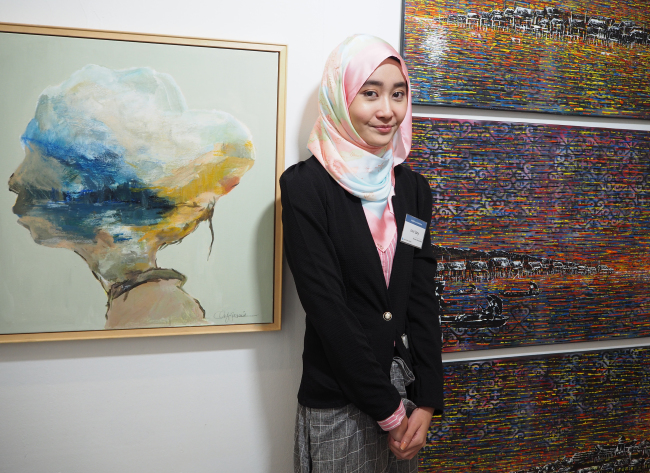 |
Bruneian artist Umi Zaty Bazillah Zakaria (Joel Lee/The Korea Herald) |
Umi Zaty Bazillah Zakaria of Brunei displayed paintings inspired by the country’s official identity: the Malay Islamic monarchy. Her paintings, separated into three canvases, portray the landmark Water Village in capital Bandar Seri Begawan, a key tourist spot there.
As Brunei is a Muslim society, artists mostly draw things related to Islam in their paintings and calligraphy, she said, adding they also experiment with trendy techniques and digital technologies. Islam-oriented works, calligraphies and portraits, among other things, “are what people buy,” she said, noting Bruneians purchase objects of art “for a specific purpose.”
Works of nudity or politically charged messages are not impermissible, but are veiled from the public eye, according to Zakaria. “You can draw those sexually or politically provocative things, but can’t really show them in public,” she said. “You need to set your own limit as an artist. Keep those things to yourself.”
By Joel Lee (
joel@heraldcorp.com)
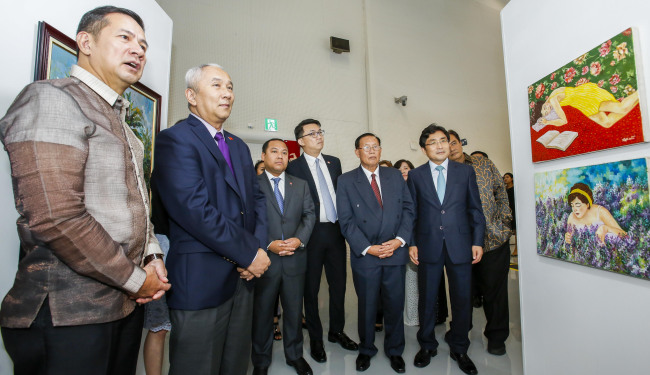 |
ASEAN ambassadors view artworks at the 2017 Asian Students and Young Artists Art Festival at Dongdaemun Design Plaza in Seoul on July 25. The exhibition runs through Aug. 20 featuring 60 works by ASEAN artists. (ASEAN-Korea Center) |













